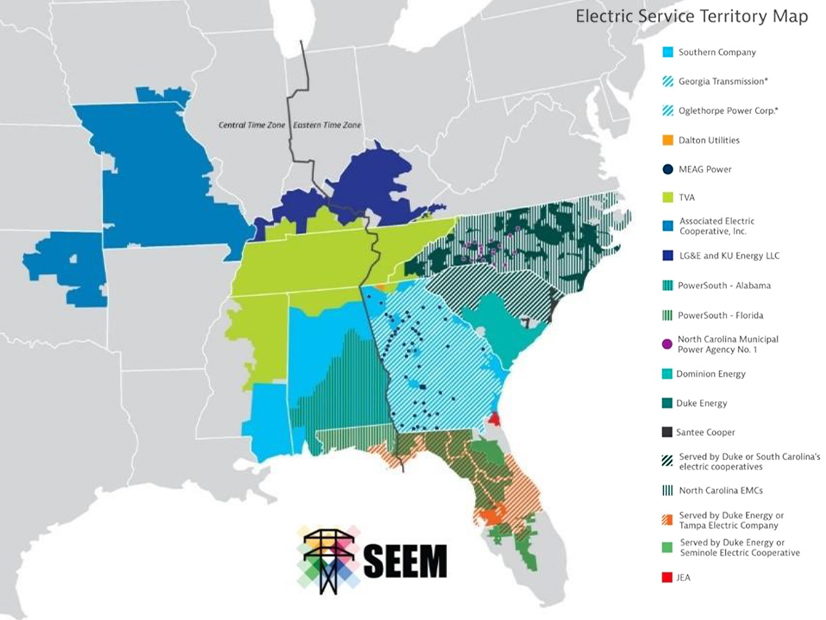
Opponents of the Southeast Energy Exchange Market (SEEM) have argued the market does not provide the benefits to customers promised by its supporters and also violates FERC’s regulations (ER21-1111, et al.).
SEEM’s opponents were responding to a filing submitted by SEEM members in August that argued the market brings savings to consumers and should be allowed to continue. (See SEEM Members Respond to FERC Briefing Request.)
FERC had requested briefings from both supporters and detractors of SEEM as a step toward satisfying a D.C. Circuit Court of Appeals order from 2023 remanding the commission’s approval of the market. (See FERC Requests Briefings on SEEM After DC Circuit Order.)
The reply briefs were filed Sept. 12 by three groups representing various longstanding opponents of SEEM:
-
- Public Interest Organizations (PIO) — a group of mostly environmental organizations including the Sierra Club, the Southern Alliance for Clean Energy, the Natural Resources Defense Council and the Partnership for Southern Equity.
- Southern Renewable Energy Association (SREA) — a trade organization promoting renewable energy in seven Southeastern states whose members include National Grid, Invenergy and Ørsted.
- Clean Trades — Advanced Energy United, the Clean Energy Buyers Association and the Solar Energy Industries Association.
The commission asked respondents to answer whether SEEM qualifies as a loose power pool under FERC Order 888 and whether the market’s requirements that entities transacting in it have a source and sink inside its footprint violate Order 888. SEEM members argued in their brief the market does not qualify as a loose power pool because “the commission has already found that NFEETS [the market’s non-firm energy exchange transmission service] is neither a discount nor a special rate” and that the D.C. Circuit did not find fault with FERC’s reasoning on that point.
However, the market’s opponents said this argument ignored the clear intent of the court’s remand order. The PIOs wrote that SEEM “has walked and quacked like an exclusive power pool” since its conception and criticized the commission and members for focusing “entirely on questions regarding definitional characterizations and technical limitations of SEEM.”
“These questions have already been asked and answered in the record and rejected by the court,” the PIOs wrote. “By delving deeply into the question of geographic limitations and alternative theories designed to justify SEEM’s existing design rather than address its core problems, both the briefing order and the utilities ignore the court’s broader concerns that SEEM’s overall design violates Order 888’s open access requirements.”
The PIOs said the D.C. Circuit’s ruling was intended to allow FERC, having seen SEEM in action, to reevaluate whether the market actually complies with Order 888. They said that contrary to supporters’ promises, “SEEM has demonstrated the need for Order 888’s protections” by systematically excluding independent power producers; the organizations claimed “no non-utility sellers have transacted in SEEM [and] just one non-SEEM utility participant” has joined the market.
‘Nominal Cost Savings’
Energy sales have been dominated by just a few utilities, the PIOs claimed, citing a report from SEEM’s market auditor showing that “a single seller accounted for between 30 and almost 80% of all sales” in the market’s first few months and the two largest sellers combined accounted for 55 to 90% of sales. The arrival of utilities from Florida in July 2023 lessened this dominance, but the PIOs observed that two sellers alone still account for more than 40% of all sales in each month.
The PIOs said that the lack of competition has resulted in only “nominal cost savings.” Sharing this view was SREA, which pointed out that while SEEM proponents originally projected benefits of $40 million annually, the market reported total benefits of $3.7 million in 2023, which “appears to be a gross benefit.” Taking estimates for annual non-centralized costs of $2.8 million and payments for legal work, auditing and platform development, SREA estimated an overall net cost of $824,591 per year.
SREA also cited data from the auditor to point out that trading on SEEM virtually shut down during the widespread blackouts arising from winter storms in December 2022, with less than 1,000 MWh traded on the platform between Dec. 23 and Dec. 27. The association also noted 53 hours this July, mostly at night, during which no trades occurred on SEEM at all. SREA quoted the market auditor’s report of “a statistically significant relationship” in which high demand is matched with decreased trading activity on SEEM.
Regarding the SEEM members’ assertion about NFEETS, the Clean Trades called their description of NFEETS as a pancaked rate a “post-hoc rationalization,” noting that members called the service “non-pancaked” when they first filed the SEEM agreement. Now, however, the Clean Trades said that members have called their previous description of NFEETS “shorthand.” They called on the commission to recognize the truth of the matter, as they described it, and treat SEEM as a loose power pool.
“The commission should reject the SEEM Members’ attempt to have their pancakes and eat them too,” the Clean Trades said. “The bottom line is that … SEEM represents a pooling arrangement that favors members over non-members through a ‘discounted’ rate. It is a textbook example of a ‘loose power pool’ and must satisfy the associated regulatory strictures.”


